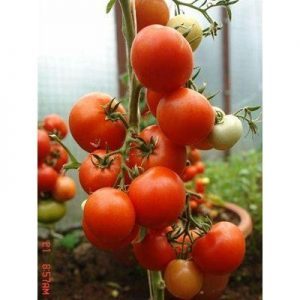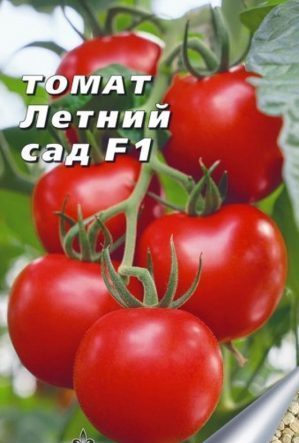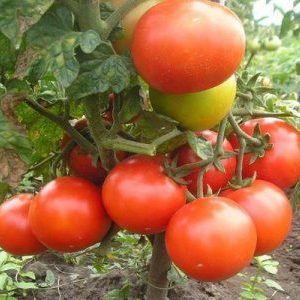Review of the early hybrid tomato "Summer Garden f1": reviews of summer residents and instructions for growing a hybrid
Early ripe varieties and hybrids of tomatoes are highly valued in our country. They allow you to harvest at the beginning of summer. For regions with a mild season of fresh vegetables, this is especially important. As a rule, early ripe tomatoes have several disadvantages. The most common of them are low palatability, hard juicy fruits and low immunity to tomato diseases.
Among the many early-ripening varieties and hybrids, the Summer Garden tomato stands out. It was appreciated by gardeners all over the country for its good taste and unpretentious care.
The content of the article
General description of the hybrid Summer Garden
Summer Garden is a first generation tomato hybrid. This is evidenced by the f1 mark in the name. The tomato is bred by crossing two other varieties.
Important! Seeds from the hybrid tomato crop are not suitable for planting. In 98% of cases, the plants grown from them acquire the characteristics of one of the crossed varieties.
Although the hybrid has appeared on the horticultural markets for a long time, its popularity has not diminished.
Distinctive features of the variety
Tomato Summer Garden characterizes early maturity. Its berries ripen in late June or early July. These are the tomatoes that first appear on the tables of gardeners.
The appearance of the fruit does not stand out in any way. The berries of the Summer Garden are round, medium-sized and orange-red in color.
The taste is ordinary tomato. Despite the early maturity, such tomatoes are not tasteless, their aroma is rich. The pulp is firm and juicy.
The tomato hybrid has a high yield. From 1 sq. m harvested more than 15 kg of fruit. These are very high figures for early ripening tomatoes.
The undersized bushes of the Summer Garden do not require garters and pinching. This feature makes growing tomato much easier.
Pleases this hybrid and immunity. It is resistant to most tomato diseases and is not afraid late blight.
Main characteristics
Description of the hybrid Summer Garden will appeal to even novice gardeners.
| Parameter | Indicators |
| Bush type | Determinant undersized hybrid. Not a standard one. The height of the bush reaches 40-50 cm. The plants are covered with an average amount of foliage. The leaves are simple, rich green, medium in size. The first simple inflorescence is formed in the axil of 6 or 7 leaves. The next ones every 1-2 sheets. The fruits are formed by tassels. 6-8 berries are formed on one cluster. |
| Growing method | In the southern and central regions, they are grown outdoors. In the northern part of the country, it is cultivated in greenhouses. |
| Yield | High. Up to 4.5 kg of berries are obtained from one bush. From 1 sq. m harvest with a total weight of up to 17 kg. |
| Fruit | They are of medium size. The weight of one berry varies between 80-140 g. The shape is rounded, leveled. There is often a slight ribbing at the base. The color is red-orange inside and outside. Inside, there may be a lighter spot at the base. Tomatoes are almost white when unripe. The taste of tomatoes is sweet and sour with a rich aroma. The fruits are fleshy, the skin is smooth and shiny. The pulp is firm, but juicy. There are many chambers in the fetus (up to 8). They contain seeds that are not suitable for planting. |
| Transportability | High.Tomatoes are stored for up to a month and do not lose their presentation during transportation. |
| Ripening terms | Early ripe tomato. Its fruits ripen 90–100 days after sowing the seeds. Fruiting continues until the end of August. |
| Disease resistance | Possesses resistance to diseases of tomatoes, including late blight. |
How to grow seedlings
Tomato Summer Garden is an early ripe hybrid. Its seedlings begin to grow 45–55 days before planting in open ground. Sowing time of planting material depends on the region:
- southern part of Russia - in early March;
- regions with a temperate climate - in early April;
- northern cities - in the second half of April.
When growing tomatoes in a greenhouse, seeds are sown two weeks earlier. Seedlings of early ripe hybrids are especially important not to overexpose in containers. Otherwise, ovaries will appear on them before the pick, which will make it difficult to take root in a new place.
Planting material processing

Before sowing, the seeds must go through a number of preparatory measures. They will allow you to get healthy seedlings:
- The verification procedure allows you to remove seeds that will not be able to germinate in advance. The planting material is soaked in a saline solution (1 tsp of salt per 1 tbsp. Of water). The floating instances are thrown away. The seeds that have sunk to the bottom are washed and used for planting.
- Etching. This procedure will reduce the risk of plant contamination. The seeds are soaked in a light pink solution of potassium permanganate for 30 minutes. or in hydrogen peroxide for 15 minutes. Then they are washed.
- Growth stimulation. Accelerate seed germination and increase their immunity to negative environmental conditions. The planting material is soaked in the preparations "Epin", "Zircon" or "Sodium humate".
Advice! If the seeds have been treated with disinfectants at the factory, then they do not need to be etched.
Preparation of containers and soil
Large containers are used for sowing tomato seeds. Special boxes and trays or packaging for cakes and semi-finished products will do.
For picking plants, you need a 300 ml container. Gardening stores sell plastic and peat pots. More budget options are disposable cups and cut bottles.
The containers are disinfected. They are soaked for 30 minutes. in a dark pink solution of potassium permanganate.
Potting soil for tomato seedlings is often prepared independently. Humus, black soil and sawdust are mixed in equal proportions. Ash is added to the composition. This soil is nutritious and light.
Purchased soil mixtures are also used. A universal soil is suitable for tomatoes.
The earth is also disinfected. It is calcined in the oven or poured with boiling water.
Sowing seeds
The soil in the boxes is watered with warm water. In the soil, grooves are made with a depth of 1 cm at a distance of 3 cm. Seeds are laid out in them with an interval of 2 cm. They are sprinkled with earth on top.
The boxes with the seeds are covered with foil and placed in a warm place with a temperature of 26 ° C. Such conditions will ensure seed germination within 2-3 days. Tomatoes do not need light during this period.
Seedling care
Strong and healthy seedlings are the key to a rich tomato harvest. To get such plants, you need to follow the rules for caring for them:
- When the seeds germinate, the film is removed, the boxes are removed in a cool, but well-lit place. After a week, the containers are transferred to heat. This will prevent the plants from pulling out.
- Young tomatoes require 16 hours of daylight. If natural light is not enough, then fluorescent lamps are used.
- Water the tomatoes as the soil dries. Use water at room temperature. It is important to ensure that the liquid does not get on the ground part of the plants.
- When real leaves appear, the seedlings dive into separate containers. Sawdust, broken ceramics, bricks or small gravel are poured at the bottom of the container.
- Tomatoes are fed three times during the entire period of growing seedlings.The first time two weeks after the picking of the plants, the second time two weeks later, the last time three days before transplanting to a permanent place. Mineral and organic dressings alternate.
- Ten days before picking to a permanent place, seedlings are hardened. She is taken out daily, gradually increasing the time she spends in the fresh air.
Agricultural technology of the Summer Garden
Plant seedlings in a permanent place when the soil temperature reaches 12 ° C. Indicators are measured at a depth of 15 cm.
The time for planting tomatoes in a permanent place depends on the region:
- the southern strip - at the end of April;
- middle band - after March 10;
- northern regions - early July.
Tomatoes are planted in the greenhouse two weeks earlier. This also applies to film shelters.
Early maturing varieties are grown by seed method. Planting material is sown in open ground in mid-May. In this case, the tomatoes will ripen only at the beginning of August.
Planting seedlings to a permanent place
Tomato beds are prepared in the fall. They are dug to the depth of the shovel handle. The soil is cleaned of plant residues and enriched with humus. If the acidity of the soil is increased, it is reduced with ash or dry lime.
In the spring, the soil in the beds is leveled with a rake. Weeds that appear are removed. For 1 sq. m dig up 4 holes. They are placed in staggered rows.
A handful of ash or granular fertilizers are poured into each depression. Pre-watered and fed seedlings are placed in them, along with a lump of earth. The depressions are sprinkled with soil.
Plants are watered. For each of them, 1 liter of water is used. The beds are covered with humus, hay or straw.
Plant care
Tying determinate tomatoes is optional. But experienced gardeners still recommend attaching the bushes of the Summer Garden to the support. They produce a large number of fruits, under the weight of which the plants tend to the ground.
Form a bush once a whole summer. Remove everything stepsons below the first flower brush. In the process of pinching, yellow, sluggish and lower leaves are removed.
Water the tomatoes as the soil dries. Use 2-3 liters of water per plant.
The soil is loosened after each glaze... This should be done so that the earth crust does not interfere with normal air exchange. In the process of loosening, all weeds are removed.
Top dressing apply 2-4 times per season (depending on how fertile the soil is). Mineral ("Superphosphate", magnesium sulfate, potassium sulfate) and organic (mullein, chicken manure solution, fermented grass) fertilizers are used.
The nuances of growing tomatoes
Tips for growing tomatoes will help you avoid many problems. The list contains the most important ones:
- The picking is carried out once a week in the early morning or after 4 pm. In one procedure, no more than three leaves are removed. Plants are not watered that day.
- When pinching, you need to remove shoots so that a small "stump" remains... This will prevent new shoots from forming in the same place.
- Shake the tomato bushes regularly. This will speed up the formation of ovaries.
- The first two weeks, tomato beds are loosened to a depth of 15 cm... Then to a depth of 8 cm.
Disease and pest control
Tomato Summer Garden rarely suffers from late blight. He also has immunity to other infections. However, you should not neglect the rules of prevention:
- All garden tools are disinfected. Pathogens of infections remain on it.
- The remains of plants are removed before planting tomatoes. The soil is disinfected.
- It is necessary to follow the rules of watering and pinching. It is important to monitor the optimum moisture content of the soil and air.
- Be sure to weed the tomato beds.
- Basil and rosemary are planted between the tomatoes. These plants repel pests.
- The walls of the greenhouse are disinfected.
- Tomatoes are treated for insects. They are sprayed with a decoction of celandine or a solution made from a bar of laundry soap and a bucket of water.Large pests are harvested by hand.
Differences between growing in open and protected ground
In a greenhouse, pathogens spread faster than outdoors. Such rooms need to be ventilated daily by opening the vents.
In a greenhouse, moisture evaporates more slowly. If in the open field tomatoes are watered two to three times a week, then in the greenhouse there is only one.
When planting tomatoes in open ground, the first two weeks are covered with foil. This is necessary to protect plants from night frosts.
Harvesting and application of the crop
Summer Garden tomatoes ripen in early July. They sing together. They are plucked from the bush with whole brushes.
The fruits are stored in a cool dry place. They will lie like this for a month.
The hybrid is suitable for fresh consumption and whole canning. Delicious blanks are made from it.
Advantages and disadvantages of a hybrid

Summer Garden benefits:
- early maturity;
- high productivity;
- rich taste;
- universality of application;
- does not require frequent pinching;
- unpretentious in care.
This tomato belongs to hybrids. Seeds from its fruits are not used for planting. Many gardeners consider this a disadvantage.
Farmers reviews
Tomato Summer Garden has good reviews. It has excellent taste and high yield.
Vitaly, Lipetsk: “I have been growing the summer garden for ten years. I use the fruits both for myself and for sale. One of the most productive early maturing hybrids. I grow in the open field. Stepson only once. The berries taste good. "
Irina, Yekaterinburg: “Every year I plant 4–6 bushes in the Summer Garden. From such a garden I collect two buckets of fruit. The tomatoes taste the most common. Their main advantage is early maturity. The berries are aligned and flavorful. I use it for preserving and preparing salads. "
Conclusion
Tomatoes Summer Garden is an early ripe hybrid that stands out among many similar varieties. It has a rich taste and rich yield. It is necessary to form a bush once a whole summer. Disease resistance makes it popular with summer residents. From a garden in 2 sq. m collect up to 35 kg of fruit.
Due to the short stature and unpretentiousness of the tomato, it will be easy to grow it.